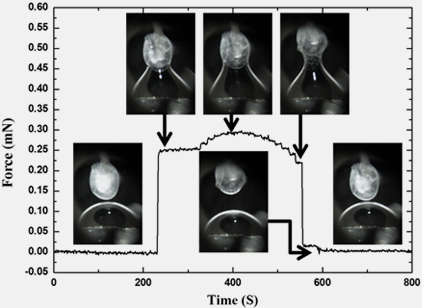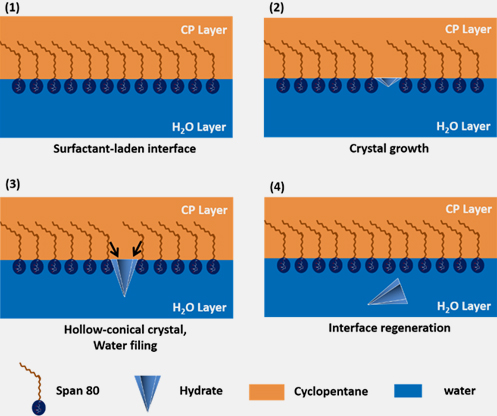|
|
|
| HOME > Research > Research Field |
| |
| Research Field |
| |
 |
| |
 Clathrate hydrates Clathrate hydrates |
| |
|
Clathrate hydrates having both physical and chemical characteristic features of ice-like materials are crystalline compounds in which guest molecules such as methane, ethane, carbon dioxide, cyclopentane (CP), etc. are entrapped in host water cages formed by the hydrogen-bonded networks of water molecules. Clathrate hydrates are evaluated as not only one of main factors for pipeline blockage in oil and gas processes (flow assurance) but also a future energy storage media for natural gas. Our laboratory mainly focus on the flow assurance problem, especially the understanding and identification of dynamic adhesion behavior and crystal growth patterns in clathrate hydrate systems.
|
| |
 |
| Figure 1. Conceptual image of hydrate plug formed in a subsea hydrocarbon pipeline |
|
|
| |
 Dynamic Adhesion Behavior between Clathrate Hydrates and Solution Droplets Dynamic Adhesion Behavior between Clathrate Hydrates and Solution Droplets |
|
During the extraction process of oil and gas, the existence of water (host), gas (guest) can lead to the formation of hydrate inside the pipeline, and thus; hydrate particles can be aggregated and agglomerated down the pipeline. Through continuous growth of hydrate particles, hydrate plugging happens, which can lead to a halt of production due to the pipeline blockage. Therefore, the interfacial dynamic adhesion behavior has to be identified essentially to understand the interaction between hydrate particles and water droplets in the pipeline.
The main goal of this proposal is to understand the dynamic adhesion interactions between clathrate hydrates and various oil-water interfaces. Elucidating the adhesion behaviors of hydrate particles in multi-phase systems consisting of gas, oil, water, and solid surfaces may provide fundamental insights into the avoidance of hydrate plugs in gas/oil delivery lines and processing units. To understand the adhesion behavior subject to the phase transition and fluid motion, the mechanism for capillary bridge formation and aggregation between hydrate particles, partially converted water droplets, and water droplets should be identified in a micro-scale domain. Then, this micro-scale adhesion mechanism can be interpreted to understand the macro-scale adhesion behaviors. We will quantify the changes in dynamic adhesion when accompanying surface-active agent (surfactants and nano-particles) injection, substrate (e.g. metal surfaces in the pipelines) aging and various surface properties of roughness, hydrophobicity, and hydrophilicity.
|
| |
 |
| Figure 2. Variations of contact force between clathrate hydrates and solution droplet from contact to detachment |
|
|
| |
 Understanding the Crystal Growth Pattern at the Water – Oil Interface Understanding the Crystal Growth Pattern at the Water – Oil Interface |
|
A batch distillation The continuous hydrate crystal growth at the interface of water – oil is evaluated as one of main factors for the hydrate plugging. In addition, the morphology, especially the size, shape and the structure of hydrates, should be considered for better understanding. Therefore, the identification of the feature of hydrate crystal growth at the water – oil interface is critical to understand the hydrate plugging mechanism in the pipeline.
The main goal of this proposal is to understand the mechanism of nucleation, crystal growth of clathrate hydrate at the water – oil interface. We will introduce the water/oil soluble surfactant and/or nano-particles into the water – oil interface and observe the growth patterns of hydrate crystal. The effects of surface-active agent injection into the water – oil interface can be monitored by the optical microscope and Micro differential scanning calorimetry.
|
| |
 |
| Figure 1. Conceptual hydrate crystal growth in the presence of oil soluble surfactant at the water – oil interface |
|
|
|
|
| |
|